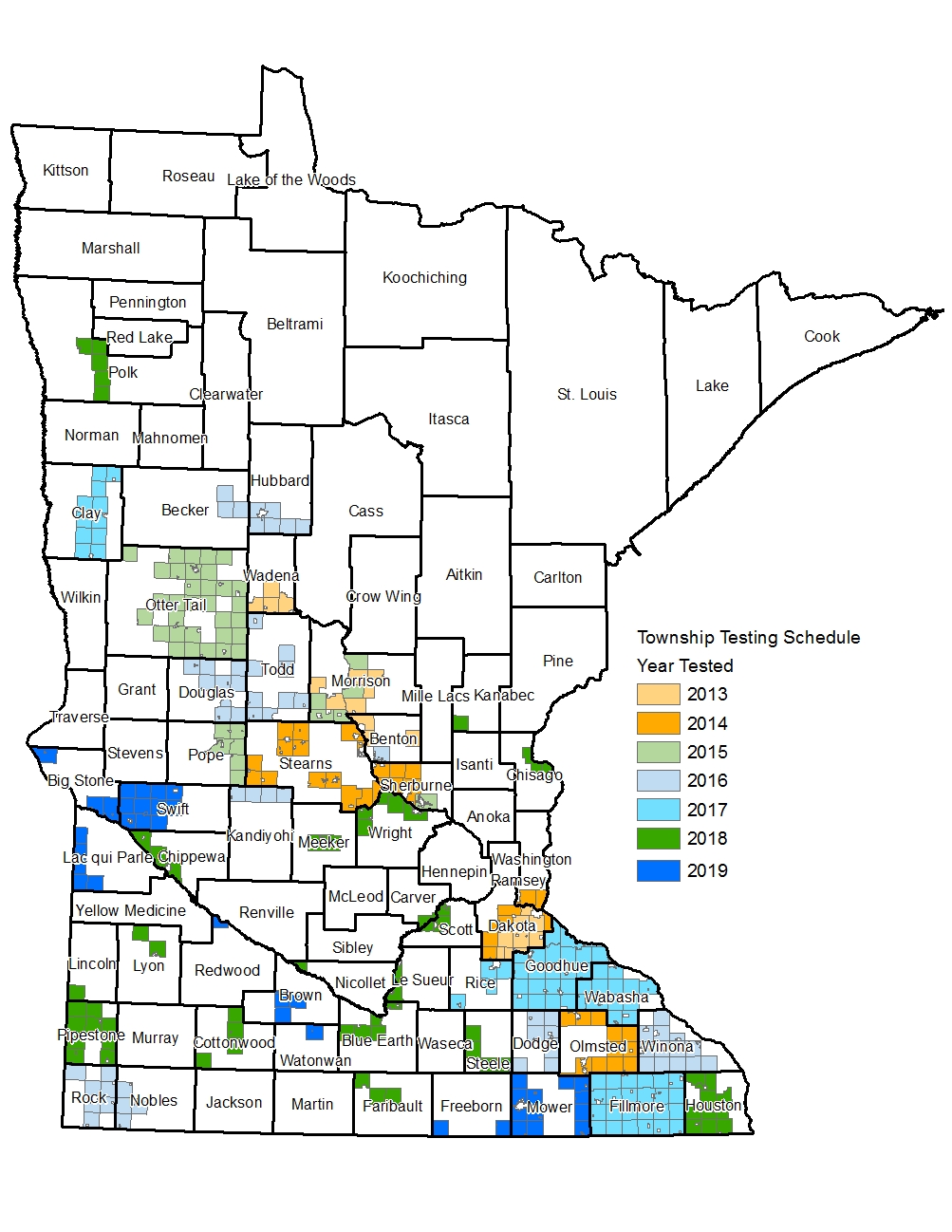Township Testing Schedule

Background on Nitrate-Nitrogen
Nitrate-nitrogen (referred to as nitrate) is a water soluble compound composed of nitrogen and oxygen that can occur naturally in groundwater at levels typically in the range of 0 to 3 parts per million (ppm). Human activities such as sewage disposal, livestock production, and crop fertilization can elevate the level of nitrate in groundwater.
The drinking water standard for nitrate is 10 ppm; any number above this nitrate level can negatively affect human health, specifically infants under the age of six months. Nitrate contamination above the drinking water standard is most commonly found in aquifers that are vulnerable to contamination from the land surface, such as sand and gravel aquifers and fractured bedrock aquifers. Areas with heavy row crop agriculture and vulnerable groundwater are especially at risk.
Our agency (MDA) significantly revised the Nitrogen Fertilizer Management Plan (NFMP) in March 2015 after working extensively with an advisory committee. The plan calls for an assessment of nitrate-nitrogen concentrations in private wells at the township scale. The MDA has identified townships across the state that are vulnerable to groundwater contamination and have significant row crop production. The schedule of testing for these priority townships is included on the map and can be found on the Township Testing Schedule and Results page. Townships that are not highlighted may also be considered if there is data to suggest there is a local groundwater problem.
More than 70,000 private well owners will be offered nitrate testing in over 300 townships (35 to 59 townships per summer) by 2019. This work will be done in partnership with local governments across the state.
Remember, private wells should be tested for bacteria at least once a year and for nitrate every year or every other year. A Minnesota Department of Health certified water testing lab can provide nitrate and bacteria testing services. Search for a certified lab nearest you.
How the Program Works
Homeowners in the identified townships will receive a sampling kit in the mail. The water sample will be collected by the homeowner and sent to the certified lab (in the prepaid mailer). If nitrate is detected in the water sample, the homeowner may be offered a subsequent test for pesticides. A trained professional will come to your house to collect the water samples for pesticide analysis. Program participants information (name, address and phone number) will remain confidential.
Funding the Program
The MDA works with Soil and Water Conservation Districts (SWCDs) and counties to coordinate the testing program in the identified townships. Funding is available to help implement the program. Priority will be given to SWCDs/counties that exhibit the ability and enthusiasm to participate and complete the work.
SWCD/County Responsibilities
- Provide overall coordination
- Develop initial list of well owners
- Promote and advertise the program
- Conduct education and outreach activities
MDA Responsibilities
- Provide funding for the program
- Assist with local coordination
- Manage and organize results
- Conduct statistical analysis and data summary
Why Participate?
SWCDs/counties will gain knowledge about the current nitrate conditions in their county to enable more informed local planning and decision-making.
Participating Townships
As of 2020, 344 vulnerable townships from 50 counties have participated in the program from 2013-2019.
Counties that have participated are listed. The number in parenthesis indicates the number of townships sampled in that county. Counties include: Becker (3), Benton (4), Big Stone (3), Blue Earth (5), Brown (3), Carver (1), Chippewa (3), Chisago (2), Clay (11), Cottonwood (4), Dakota (15), Dodge (7), Douglas (9), Faribault (3), Fillmore (24), Freeborn (2), Goodhue (22), Houston (10), Hubbard (6), Kanabec (1), Kandiyohi (4), Lac qui Parle (5), Le Sueur (2), Lincoln (1), Lyon (2), Meeker (2), Morrison (11), Mower (12), Nicollet (1), Nobles (4), Olmsted (11), Otter Tail (32), Pipestone (9), Polk (5), Pope (6), Redwood (1), Rice (4), Rock (7), Scott (4), Sherburne (6), Stearns (14), Steel (4), Swift (11), Todd (9), Wabasha (14), Wadena (4), Washington (2), Watonwan (1), Winona (13), and Wright (5). For more information, please contact Kimberly Kaiser.
Results
Results from individual wells are sent directly to the well owner (homeowner), along with a letter explaining the results.
After the MDA receives all the well testing results in a township, we analyze and review all information and data about well depth, age and construction. In some cases, visits to wells may be needed to confirm results. After the analysis is complete, our agency writes a summary document and sends it to the local partner (county, SWCD, health department). We will post summary documents on this web page after the local partner has had a chance to review results and share the information with their community. The MDA uses the final results to determine if additional action is needed, as described in the Minnesota Nitrogen Fertilizer Management Plan (NFMP)
Summary of Current Initial and Final Nitrate Testing for Private Wells
- Township Testing Program Update - May 2022 (PDF)
- Township Testing Program Initial Nitrate Testing Results May 2022-MAP (PDF)
- Township Testing Program Final Nitrate Testing Results May 2022-MAP (PDF)
- Nitrate Testing Final Results for Private Wells May 2022-TABLE (PDF)
The most recent reports are listed below. To see all reports visit Township Testing Schedule and Results.
Final Results
2022
- Freeborn County: Final Overview of Nitrate Levels in Private Wells (2019-2020)*
- Freeborn County: Final Township Testing Nitrate Report, 2019-2020*
- Redwood County: Final Overview of Nitrate Levels in Private Wells (2019-2020)*
- Redwood County: Final Township Testing Nitrate Report, 2019-2020*
- Watonwan County: Final Overview of Nitrate Levels in Private Wells (2019-2020)*
- Watonwan County: Final Township Testing Nitrate Report, 2019-2020*
*Document is located in the Minnesota Digital Water Research Library.

